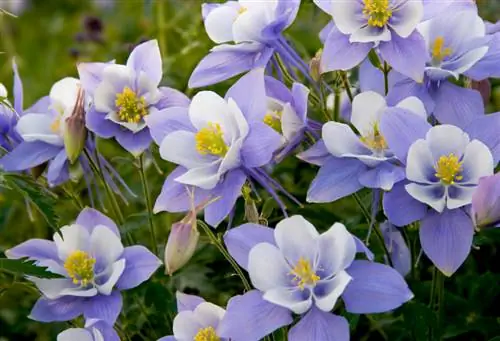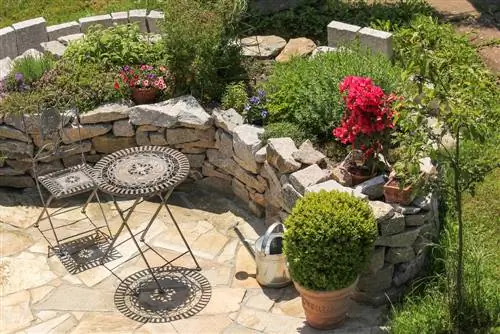- Author admin [email protected].
- Public 2023-12-25 17:45.
- Last modified 2025-01-23 11:21.
Ehrenpreis spoils us with sky-blue flower clouds and magnificent Veronica candles in the rock garden, the perennial bed and along the pond bank. So that the virtuoso perennial of the year decorates the garden for a long time, all important questions about the cultivation of the diverse plant should be clarified. Discover expert answers here.

How to plant and care for speedwell in the garden?
The speedwell is a versatile perennial with sky-blue flowers that thrives in rock gardens, perennial beds and pond banks. Planting time is spring and fall, and care includes watering, fertilizing and pruning. Speedwell is hardy and can be propagated by sowing, dividing or cuttings.
Plant speedwell correctly
In order to live up to its status as perennial of the year, professional planting creates the best starting conditions. Planting times include spring from mid-May or a mild day in September/October. The still potted root ball is soaked in water in a container while you prepare the soil. If the flower requires nutrient-rich soil, add compost and horn shavings. For a rock garden plant, enrich the clod with a little sand and fine grit. After the preparation, proceed as follows:
- Dig a pit with 1-5 times the volume of the root ball
- Unpot the plant and plant it in the optimized soil up to the lower pair of leaves
- Press the substrate with your hands and water it
If it is a perennial that grows as tall as a man, place a support post in the immediate vicinity and tie the plant with raffia or special ties.
Care tips
If you assign a species-appropriate location to Ehrenpreis, the care program is limited to the following factors:
- Water the perennial in summer drought
- Fertilize with compost and horn shavings at the beginning of the flowering period
- Cut off wilted flowers for autumnal rebloom
- Pruning of wintergreen species close to the ground is carried out in spring
The frost-resistant plant does not require winter protection. However, you should cover a bucket or flower box thickly with bubble wrap and place the container on wood so that the root ball does not freeze. For safety reasons, small pots are moved to a frost-free winter quarters.
Which location is suitable?
The Association of German Perennial Gardeners pays tribute to the versatility of Ehrenpreis by naming the flower Perennial of the Year 2007. The plant expresses its virtuosity not least with regard to the divergent location requirements that its numerous species cover. A small excerpt from more than 450 species:
- Meadow speedwell: sunny location in a fresh, moist perennial bed, nutrient-rich and well-drained
- Stemed speedwell: sunny to partially shaded location in sandy-loamy to dry soil, rich in lime
- Candelabra speedwell: sunny to partially shaded place with moist soil without waterlogging
- Bachbunge: sunny to partially shaded locations with moist to wet soil with a slightly acidic component
The correct planting distance
Within the multifaceted genus, specimens can be found with growth heights between a graceful 10 cm and a breathtaking 2 meters. For guidance, we have listed the most important data for the ideal planting distance below:
- Growth height 10-15 cm and width 20-30 cm corresponds to a planting distance of 30 cm
- Growth height 20-30 cm and width 20-30 cm corresponds to a planting distance of 25 cm
- Growth height 50-80 cm and width 30-40 cm corresponds to a planting distance of 40 cm
- Growth height 90-140 cm and width 60-90 cm corresponds to a planting distance of 90 cm
The powerful candelabra speedwell varieties all clearly exceed the 1 meter mark and should be planted in such a way that one specimen thrives per square meter.
What soil does the plant need?
With regard to the nature of the soil, no universal statement can be made for the speedwell flower. Match the soil to your favorite perennial so that it can develop to its full potential. For example, a stream in the rock garden floor will languish sadly, while the moisture-loving plant will thrive in the muddy bank area of your pond. In order for the largest species, the candelabra speedwell, to develop its majestic stature, it needs fresh, moist, nutrient-rich and humus-rich soil.
What is the best time to plant?
Plant a speedwell perennial that you have grown yourself or purchased ready-made, either in May or September. If you plant the flower in the garden by sowing, the suitable time window is in April and May. Alternatively, you can prefer the plant behind glass, which is possible from mid to late February when the lighting conditions on the windowsill improve.
When is flowering time?
From spring to the first frost, the tireless flower will decorate the garden and the planter if you find the right combination. With more than 450 speedwell species and countless varieties, you can confidently make the most of it. The following suggestion may spark your ideas:
- Pedunculated speedwell: flowering period from April to August
- Meadow speedwell: flowering period from May to July and subsequent flowering in September/October
- Long-leaved speedwell: flowering from July to August and remontant until the first frost
Since the plant has a remontant property, you can extend the flowering period by weeks as you wish. To do this, for the species suitable for this purpose, simply cut the perennial back after the first flowering by a third to a hand's width above the ground.
Cut speedwell correctly
The majority of speedwell thrives as a remontant perennial. This characteristic implies the ability to rebloom by cutting off the flower pile by a third to a hand's width above the ground after the first round. If you want to propagate the flower by self-sowing, some specimens should be excluded from pruning. The plant receives its main pruning in early spring, shortly before fresh shoots appear. Until then, numerous wintergreen Veronica varieties will decorate the otherwise dreary garden
Pour speedwell
Water the perennial so that it never dries out. The location conditions determine the frequency. Check the moisture content of the soil every 2-3 days to decide on the water needs for each flower individually. For a plant in a pot or balcony box, there is regularly an increased demand for water due to the limited substrate volume.
Fertilize speedwell properly
In nutrient-rich soil, speedwell develops its magnificent habit with long-lasting flowers on its own. If the soil does not meet ideal conditions, the perennial will gladly accept organic starter fertilization at the beginning of the flowering period. Compost, leaf mold, guano, bark humus, horn shavings or plant manure are suitable. However, avoid giving nitrogen-rich complete fertilizer, as this promotes leaf growth at the expense of flowers.
Wintering
As a native perennial, speedwell is completely hardy. With the beginning of the frosty season, the above-ground parts of the plants die off from deciduous species. A wintergreen plant waits until early spring before collecting its leaves. Fresh shoots emerge from the overwintered rootstock at the beginning of the growing season. Therefore, no special precautions need to be taken in the bed. In the pot and balcony box, there is of course a risk that the root ball will freeze. As a precaution, vessels with a diameter of less than 30 cm should be moved to frost-free winter quarters.
Increase honorary prize
Although the plant reproduces diligently in the bed using runners and seeds, Ehrenpreis friends are still on the lookout for methods of controlled breeding. Choose from the following approaches:
- Sowing behind glass from mid-February
- Sowing directly in the bed in April and May
- Division of the rootstock in spring
- Head cuttings during the summer flowering period
If it is a runner-forming plant, separate strong root strands and divide them into 10-15 cm long segments. As long as a section has at least one bud, it will quickly transform into an adult flower in suitable soil.
How do I transplant correctly?
As an extremely long-lived perennial, speedwell only requires rejuvenation through division and transplanting every 6 to 10 years. If the plant gradually becomes bald from the middle, you should take action in April. Dig up the entire rootstock and shake off the soil. Use a sharp knife or spade to divide the plant into two or more segments. Cut out the atrophied areas completely so that they can be disposed of. Place the rejuvenated perennial in fresh soil at the current or new location, maintaining the previous planting depth.
Is speedwell poisonous?
A variety of opulent speedwell species are rich in valuable ingredients. Therefore, the herbaceous plant has played a role in folk medicine for generations. Essential oils primarily help to relieve respiratory diseases. In addition, the tender leaves of speedwell (Veronica officinalis) and other species, similar to watercress, can be prepared into a delicious vegetable or fresh salad. There can be no question of any toxic content in this perennial.
How can I effectively combat speedwell in the lawn?
Veronica doesn't always cause enthusiasm when it spreads out in the garden. First and foremost, its sky blue flowers are not welcome in the lawn. Since the perennial grows much more frugally and undemandingly than the noble lawn grasses, it wins the race for dominance. As a result, the previously velvety green lawn is transformed into a holey patchwork quilt. It doesn't have to come to that. The following methods have proven effective in controlling speedwell in the lawn:
- Mechanical control: Scarify regularly; Cut out individual copies
- Chemical control with Banvel M, Weedex or Hedomat
Do not mow the lawn deeper than 4 cm. In this way, the lawn grasses cast enough shadow on the plant so that it is cut off from sunlight and photosynthesis comes to a standstill.read more
Beautiful varieties
- Blue John: Violet-blue meadow speedwell, which is convincing experts in current sightings; Growth height 50-80 cm
- Georgian Blue: stalked speedwell as a magnificent deep blue ground cover for the rock garden and the grave; Growth height 10-15 cm
- Bachbunge: Moisture-tolerant stream flower that stands out at the edge of the pond with blue flowers; Growth height 20-30 cm
- Pink Damask: Long-leaved speedwell as a premium variety with lilac or pink flower candles; Growth height 50-60 cm
- Heidekind: The perfect variety for the flower-filled steppe and cottage garden with purple-pink spikes, height 30 cm
- Silbersee: Silvery shimmering foliage underlines picturesque deep blue flower spikes on creeping shoots; Growth height 15-20 cm
- Apollo: Majestic speedwell whose flower candles consist of lavender blue star petals; Growth height 140 cm






